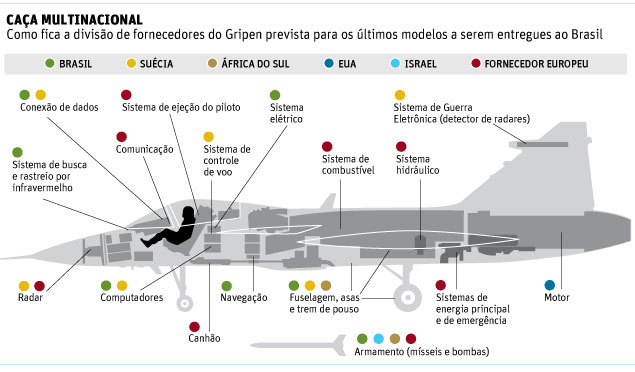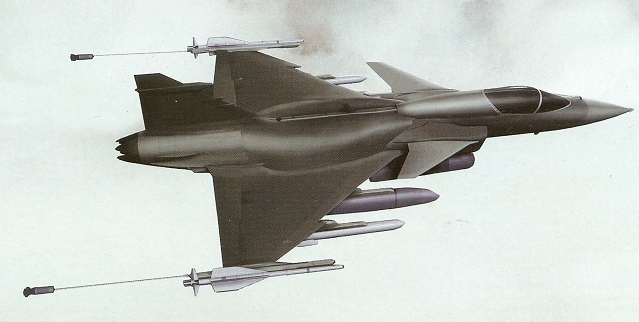Projeto escreveu:Achei uma ótima análise:
Brazil’s Gamble on Gripen Offsets
(Source: Defense-Aerospace.com; published Dec. 20, 2013)
By Giovanni de Briganti
PARIS --- If the rampant triumphalism of former French President Nicolas Sarkozy finally proved as catastrophic to Rafale’s chances in Brazil as it did in the United Arab Emirates, it cannot alone explain why Brazil dropped its long-standing preference for a twin-engined fighter to go for the low-cost, single-engined option. The reasons, unsurprisingly, have nothing to do with military requirements or with aircraft performance.
Sarkozy’s brashness, and his complete ignorance of diplomatic niceties, convinced him that both countries had committed to Rafale just because their leaders hadn’t refused his offers point-blank, and had not publicly contradicted his wildly optimistic claims. Moreover, Sarkozy had ruffled so many Brazilian feathers that lame-duck former President Luiz Inacio Lula da Silva felt unable to sign a Rafale contract before leaving office, and passed the decision to his more skeptical successor, Dilma Roussef.
A left-wing trade unionist who had a very bad time under Brazil’s military dictatorship, Roussef has little time for the military in general, and would have been quite content to let the FX-2 fighter competition wither quietly away. However, air force commander Gen. Juniti Saito has been repeating since the summer that Brazil’s dozen ex-French air force Mirage 2000C fighters, that he says are too old to keep flying, must be retired. Coincidentally, they will in fact be officially retired today, Dec. 20.
Saito, incidentally, is no fan of the French, and given the Mirage 2000’s robust airframe and engine he may well have painted a blacker picture than their condition really warrants, just to get a new fighter buy rolling. Saito, incidentally, has been air force commander since 2007 -- an abnormally long time to hold such a position -- and shows no sign of relinquishing it.
Roussef is no fan of the US, either, which at the time backed the military dictatorship, but was tilting towards the Super Hornet when the NSA spying scandal broke. This caused her to abruptly cancel an official visit to Washington, and is widely interpreted as having killed off the Super Hornet’s chances.
Strange timing
Few expected Brazil to buy a new fighter in the next year or two, since it faces huge economic problems compounded by inordinately high expenses to host the football World Cup. There also was no expectation that Sweden would let its own Gripen contracts this year.
Yet, on Dec. 18, Saab announced the Swedish government had awarded the Gripen E’s $2.5 billion full-scale development contract, followed a little later by a separate contract to integrate the MBDA Meteor air-to-air missile on Gripen.
It was only after these contracts had been made public that Defense Minister Amorim and air force commander Saito together announced that Gripen had won the FX-2 competition.
You don’t need a crystal ball to understand that there was a lot of behind-the-scenes activity, and that phone traffic between Brazil and Sweden must have hit a peak. What is still unclear, however, is what made President Dilma Roussef change her mind about the timing of the fighter buy; why the announcement took place at the Ministry of Defense instead of the Presidential palace; and why Roussef didn’t show up. Was she sulking?
The obvious conclusion is that she was forced into the decision against her will, but this is pure speculation. It will take some time for the truth to out.
Vague selection criteria
Amorim on Dec. 18 told reporters that Gripen E won the competition for three main reasons: performance, technology transfer and lower acquisition and operating costs.
“The final choice was based on these three factors," he said, while Saito stressed that offsets offered by Saab weighed in its favor: “Several industries that have offered to contribute to the development of the aircraft. At the end of development, we will have access to all the technology of the aircraft." Roussef, whose decision this was reputed to be, did not show up.
In terms of cost, there is no doubt that Gripen is far less costly to buy and operate than both Rafale and its US-made rival, the Boeing F-18E Super Hornet – both twin-engined aircraft half as large again as Gripen. Unofficial reports from Brazil claiming that Gripen costs about half as much as the other two are very plausible.
And there’s more. Senator Ricardo Ferraço, chairman of the Brazilian Senate’s Foreign Affairs committee, was quoted by the O Globo newspaper on Dec. 19 as saying that Saab is providing customer finance for the deal to the extent that Brazil will only start paying after it receives the 36th and final aircraft.
A far bigger prize?
Or will the 36th Gripen really be Brazil’s final one? O Globo also says that Brazil’s total requirement is for 100 or more fighters, and Gripen E will be the natural choice if it can demonstrate satisfactory performance and availability.
In terms of capability, there is no doubt that Gripen is outclassed by the other two in terms of range, payload and weapons, although the question here must be “how much is enough” for Brazil rather than “what is the absolute best.”
In its “Question and Answers” release (our translation here), Brazil’s MoD noted that the Gripen NGs are “supersonic airplanes that fulfil several missions, such as interception, interdiction and eventual destruction of targets….The aircraft are designed for use in air-to-air, air-to-sea and air-to-ground missions [and] are also equipped with an in-flight refueling system that will allow the defense of the airspace in even the most remote parts of Brazil.”
Nothing unique to Gripen there, of course, but it all sounds very impressive to people who have no knowledge of military aviation, i.e. the average voter.
Gripen E good enough
If one can believe the Swiss air force’s evaluation of Gripen F, (PDF, see page 6--Ed.) and there is no reason not to, its official conclusions as to the future fighter’s military performance are of interest.
On a scale of 1 to 9, the Swiss air force graded the two-seat Gripen F at 5.81 (“barely sufficient”) for operational effectiveness; 6.87 (“satisfactory”) for operational aptitude, 7.37 (satisfactory”) for “cooperation,” with a global mark of 6.36 (“satisfactory”).
Brazil is not Switzerland, however, and flying over long stretches of thick jungle, or over the maritime approaches known locally as the “Pre-Sal,” in a single-engine fighter would make many pilots nervous. Many think that the added safety of a second engine, and possibly a second crewman as well, would make much sense for such a large country.
But, in the final analysis, this did not count for much compared to the fact that both Rafale and the Super Hornet would have been financially exorbitant for Brazil’s current circumstances.
So, technology transfer and direct offsets were clearly a major boost for Gripen, and Amorim told reporters that Saab’s willingness to hand over intellectual property rights to the aircraft’s technology was what had tipped the balance in its favor. Brazil’s overall economic policies and its National Defense Strategy both have the goal of modernizing national industry and, specifically, its aerospace and defense sector, so the Swedish commitment to tech transfer is a big deal.
Much of Gripen E’s technology, however, belongs not to Saab but to its partners and subcontractors in the United States, United Kingdom and European countries. Also, given that Saab has made similar promises to Swiss industry, it is unclear how much technology Brazil will, in fact, end up with.
Brazil has also been promised exclusive rights to market the Gripen in South America, according to local press reports, but again it is unclear why its neighbors would buy combat aircraft from the regional power, rather than Sweden, and even less clear why Brazil would provide them, thereby giving away whatever technological edge Gripen E can provide.
France’s biggest mistake in Brazil
Apart from Sarkozy’s antics, French industry made a serious mistake in Brazil when it sold the 20% equity stake that Dassault and its Rafale partners acquired in Embraer, the Brazilian state-owned aircraft manufacturer, when it was privatized in 1994.
French manufacturers enjoyed good relations with Mauricio Botelho, Embraer’s first post-privatization chief executive, but when he left in 2007 relations turned frosty with his successors. This seriously complicated France’s bid, as thus lost its most influential local ally. And this was disastrous, as inevitably, Embraer became the local FX-2 prime contractor.
Embraer’s new management considered that development of the Rafale was too far along for Brazilian industry to gain any meaningful benefit in terms of new technologies and advanced R&D work. The ambitious Brazilians thought the Gripen E, which is still largely in development, would offer far greater scope for them than would Rafale, and they have been largely proven right.
Today, Rafale is already flying with an AESA radar and the new equipment required for the final, F3 version. The next development step, its mid-life upgrade, is well over a decade away.
Gripen E, on the other hand, requires several more years of development work – initial deliveries to Brazil are tentatively scheduled for 2018 – and here Brazil can, in theory, obtain both new technology and high-tech involvement for its industry.
Ironically, had Brazil bought Rafale in 2010, its industry would have been able to play a significant role in the development of the French fighter’s uprated version, but since then the program has advanced, and technological windows of opportunity have closed.
Brazil sold an offset dummy?
Needless to say, given that it is approaching the end of its production life, the Super Hornet could offer little in the way of tech transfer, and only direct offsets in assembly and some metal-bashing, things that Brazil would shun as bringing little or no technological added value.
Rumors floating around that the Super Hornet was the air force’s dream fighter are as far-fetched as those claiming that Brazil will now support Saab’s pipe dream of developing a Sea Gripen carrier version.
But it is precisely in respect of tech transfers that lobbying by the Brazilian air force and Embraer in favor of Gripen E is difficult to understand.
First of all, as already noted, many of Gripen E’s major systems and components are supplied by the United States or the United Kingdom, which not only leaves Brazil vulnerable to embargoes and/or remote interference by its suppliers, but also means that little or no sensitive US technology will be provided because such is not the American way.
The Gripen E’s engine, the F414G turbojet, is made by General Electric, its AESA radar is made by the English side of Selex ES, and several other US and UK companies are already involved in the program.
Furthermore, while Switzerland has a smaller order (22 aircraft planned), it has had a head-start in negotiating a role in Gripen E for its industry; all this adds up to a less significant role than Brazilian industry might feel it deserves. So, if Brazil chose Gripen because it offers technological windows of opportunity for its industry, it got it wrong. In reality, these windows are now largely closed because the most lucrative work has already been awarded.
There is no question that, for its cost, Gripen E is a perfectly respectable combat aircraft, with soon a high-performance weapons range while users of previous versions appear satisfied. Still, Brazilian explanations of their surprise choice make little sense.
Brazilian officials say they chose Gripen E for its price (credible), for its performance (“barely sufficient”) and for its industrial offsets (dubious end result). Brazil and Saab have allowed 12 months to complete negotiations on the contract and on related offsets, so there is plenty of time to see whether the two parties, with an offset-fixated Switzerland looking over their shoulder, can come up with an offset package that is mutually acceptable both in dollar volume and in technological content.
Story history: Minor editing changes on Oct. 20
-ends-
http://www.defense-aerospace.com/cgi-bi ... 0426&cat=5 


